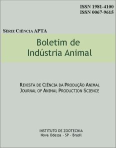Milk production from crossbred cows in elephant grass and tanzania guinea grass pastures in São Paulo
Keywords:
forage mass, Panicum maximum Jacq. cv. Tanzania, Pennisetum purpureum Schum cv. Gauçu, rotational grazingAbstract
The aim of this study was to evaluate some agronomic characteristics of elephant grass cv. Guaçu and tanzania guinea grass, during four grazing cycles, in two consecutive years, and the milk yield of crossbred cows grazing in rotation on the two areas. The grazing method was rotational grazing system. For the 1st and 2nd years, the results for elephant grass were 7,781 and 5,321kg of DM ha-1 of FM pre grazing and 2,658 and 2,730kg of DM ha-1 of residual mass, respectively. Considering the grazing cycles, no difference was observed for FM pre grazing for the 1st year but it was different for the 2nd year. The results for the 1st year were 7,715; 7,678; 8,534 and 7,510kg of DM ha-1 and 2nd year were 6,358; 4,727; 5,548 and 4,133kg of DM ha-1 of pre grazing FM for 1st 2nd 3rd and 4th grazing cycles, respectively. For Tanzania guinea grass, the averages were 5,000 and 5,384kg of DM ha-1 of pre grazing FM and 2,287 and 2,819kg of DM ha-1 of residual mass for the 1st and 2nd years respectively. There was difference for grazing cycles on pre grazing FM in the two studied years. The results for the 1st years were 5,501; 5,825; 5,631 and 4,382kg of DM ha-1 of pre grazing FM and in the 2nd year were 5,411; 6,000; 5,736 e 4,068kg of DM ha-1 of pre grazing FM for 1st 2nd 3rd and 4th grazing cycles, respectively. No difference was observed in daily milk production, and the average per cow was 10.7 and 10.6kg in elephant grass and 10.8 and 10.1kg in Tanzania grass, respectively. The coefficient of correlation between milk production and percentage of leaves in FM was 0.77 and between milk production and percentage of leaves in residue was 0.61.
Downloads
Downloads
Published
Issue
Section
License
Os autores não serão remunerados pela publicação de trabalhos, pois devem abrir mão de seus direitos autorais em favor deste periódico. Por outro lado, os autores ficam autorizados a publicar seus artigos, simultaneamente, em repositórios da instituição de sua origem, desde que citada a fonte da publicação original seja Boletim de Indústria Animal. A revista se reserva o direito de efetuar, nos originais, alterações de ordem normativa, ortográfica e gramatical, com vistas a manter o padrão culto da língua e a credibilidade do veículo. Respeitará, no entanto, o estilo de escrever dos autores. Alterações, correções ou sugestões de ordem conceitual serão encaminhadas aos autores, quando necessário. Nesses casos, os artigos, depois de adequados, deverão ser submetidos a nova apreciação. As opiniões emitidas pelos autores dos artigos são de sua exclusiva responsabilidade. Todo o conteúdo deste periódico, exceto onde está identificado, está licenciado sob a Licença Creative Commons Attribution (CC-BY-NC). A condição BY implica que os licenciados podem copiar, distribuir, exibir e executar a obra e fazer trabalhos derivados com base em que só se dão o autor ou licenciante os créditos na forma especificada por estes. A cláusula NC significa que os licenciados podem copiar, distribuir, exibir e executar a obra e fazer trabalhos derivados com base apenas para fins não comerciais.













